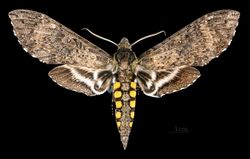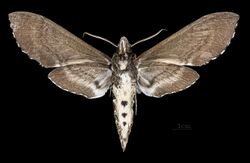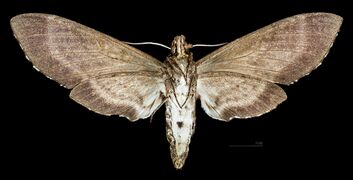Biology:Manduca occulta
| Occult sphinx | |
|---|---|

| |
| Manduca occulta ♂ | |

| |
| Manduca occulta ♂ △ | |
| Scientific classification | |
| Domain: | Eukaryota |
| Kingdom: | Animalia |
| Phylum: | Arthropoda |
| Class: | Insecta |
| Order: | Lepidoptera |
| Family: | Sphingidae |
| Genus: | Manduca |
| Species: | M. occulta
|
| Binomial name | |
| Manduca occulta (Rothschild & Jordan, 1903)[1]
| |
| Synonyms | |
| |
Manduca occulta, the occult sphinx, is a moth of the family Sphingidae.
Distribution
The species was first described by Rothschild & Karl Jordan in 1903. It is found from Panama north through Central America (including Belize, Guatemala, Nicaragua and Costa Rica) and Mexico to southern Arizona and on occasion southern Florida.[2]
Description
The wingspan is 105–120 mm. It is similar to Manduca diffissa tropicalis and can be distinguished only by a study of the genitalia. There are brownish-black bands on the hindwing underside.
Biology
There is one generation per year in Costa Rica with adults on wing from May to June. In Nicaragua, adults have been recorded from July to August and in October. Strays in Florida have been recorded in September. They feed on the nectar of various flowers.
The larvae feed on Cestrum glanduliferum, Cestrum racemosum, Solanum accrescens and Solanum hazenii.
References
- ↑ "CATE Creating a Taxonomic eScience - Sphingidae". Cate-sphingidae.org. http://www.cate-sphingidae.org/taxonomy/Manduca/occulta.html.
 This article incorporates text from this source, which is in the public domain.
This article incorporates text from this source, which is in the public domain.
- ↑ "Silkmoths". Silkmoths.bizland.com. 2010-07-21. Archived from the original on 2013-05-11. https://web.archive.org/web/20130511222124/http://www.silkmoths.bizland.com/mocculta.htm. Retrieved 2011-11-01.
External links
- Occult Sphinx Moths of North America
Wikidata ☰ Q147998 entry
 |



